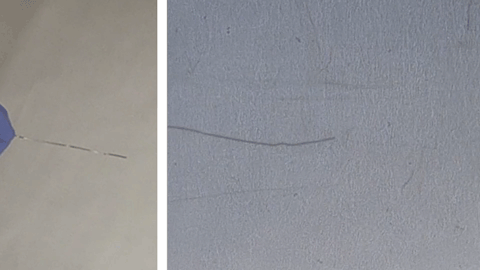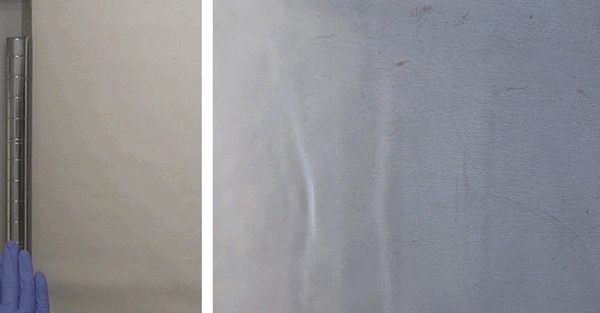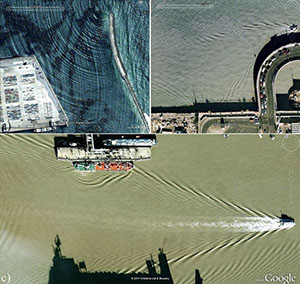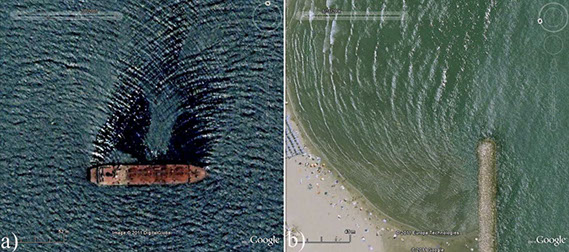SciGen Teacher Dashboard
Unit E4
Making Waves
Photo courtesy Harvard Natural Sciences Lecture Demonstrations Demo: Ripple Tank
Demo: Ripple Tank
Duration: Approximately 70 minutes plus 30-minute exploratory extension
In this demo, students closely observe some basic properties and behaviors of waves, including propagation, reflection, refraction, and diffraction, using a ripple tank in the classroom. Then students use a wave simulator. Finally, students look for real-world, large-scale examples of wave reflection, interference, and refraction around the globe.
LEARNING OBJECTIVES
Students closely examine some basic properties and behaviors of waves, including propagation, reflection, refraction, and diffraction, using a ripple tank in the classroom and a simulation.
They observe that the medium (in this case, water) does not move with the wave.
Teacher Tips
- This activity has been written as a front-of-class demo, but it would work well as a free-exploration station for students to visit in pairs or small groups. If you decide to use stations,, shorten the structured instructional time and give more time for "free play" (after two or three quick demos of using the tank).
- Always try demos on your own before doing it in front of students. (Or be prepared to troubleshoot in front of them to model perseverance!)
- Try the wave simulation yourself before having the class do it.
- Try both single pulses and series of pulses for every test in the demo. Repeating wave cycles may make patterns that will confuse your students. Some ripple tank trials show up most clearly with single pulses rather than sets of waves.
- When schools had overhead projectors (OHPs), teachers could place the ripple tank on the projection surface of the OHP for easy viewing. If your school still has its OHPs, you can skip much of the setup described below.
- Make sure the tank is level if you want to make simple waves (like circular patterns out from the surface pulses).
- Note: E4.6 includes some animations of tsunami propagation (waves slowing down but growing in size as they come ashore), which may help some students picture what would happen in a tank without a consistent depth.
- Water may splash or spill onto the table and floor around the ripple tank. Be prepared to clean up wayward water by having rags, sponges, and/or a mop on hand.
- Keep any power cords, electric lights, or motor wires as far away as possible from the ripple tank.
While ripple tanks manufactured for physics classrooms often cost hundreds of dollars, a simple, shallow tank of water lit from above or below suffices for the simple demonstrations shown in this lesson. The larger the better!Possible sources:a box-shaped, acrylic picture frame (can often be found at thrift shops)a glass or borosilicate baking dish (brand-name Pyrex--preferably without a brand printed/embossed in the middle)the disposable plastic cover for a sheet cakean aquarium / terrarium with a clear bottom, turned upside down with the light source inside the tankMaterials
- a shallow, clear plastic or glass tray
- two heavy books or bricks to hold the tray in place
- two desks or tables of exactly the same height
- water
-
bright point source of light, such as a Maglite or the flashlight app from your mobile phone
- optional: a strobe light, or a strobe light app from your phone
- optional: a tripod to hold your flashlight above/below the ripple tank (We used a “Joby gorillapod” to hold our mobile phone for our filming.)
- optional: stiff wire (like a straightened paper clip), a pen/pencil, an eyedropper
- some kind of rod: a short length of PVC tube, a wide metal rod, or round wooden dowel, or even several markers connected cap-to-end. The rod should have a diameter wider than the depth of your water. The rod should be narrower than the shorter side of your tank.
- a straight barrier (We made ours out of Lego bricks.)
- for refraction: transparent plates of acrylic or glass to make the depth of the tank shallower
-
 concave barriers in the shape of semicircles, parabolas, or non-water-soluble clay to approximate these shapes
concave barriers in the shape of semicircles, parabolas, or non-water-soluble clay to approximate these shapes
- hint: If you have a 3D-printer, use that to make simple parabolic and semicircular barriers. We made a semi-circle by splitting in half the plastic cover of a stack of recordable DVDs. Take-out containers or buckets may come in the shape you need.
- for optional extension using Google maps: electronic device (such as computer, laptop, tablet)
Teacher Tune-ups
Teaching Notes
ACTIVITY OVERVIEW
- Before class: set up ripple tank (10 minutes)
- Introduce familiar wave interference patterns (5 minutes)
- Make radiating wave patterns (5 minutes)
- Make linear wave patterns (5 minutes)
- Bounce patterns off different kinds of barriers (10 minutes)
- Free play (5 minutes)
- Refract water waves (15 minutes)
- Explore wave behavior with a simulator (15 minutes)
- Optional extension: explore wave patterns on Google Earth (30 minutes)
Before class: set up ripple tank (10 minutes)
Why does this work?
As the light passes through the thin layer of water, some of it is absorbed: more light is absorbed where the water is deeper (as with a wave crest, which will appear as a darker area) than where it is shallower (like in a trough, which will appear as a brighter area). When a wave hits some kind of an obstacle, these water waves react as all waves do.
Bird's-eye view of setup

Side view of two setups
(projecting onto ceiling, left; projecting onto floor, right)
Introduce familiar wave interference patterns (5 minutes)
Paraphrase:
Have you ever noticed the patterns that pebbles or raindrops make when they land on the surface of a pond or puddle?
Display and discuss video.
Ask students:
Make radiating wave patterns (5 minutes)
Using a stiff wire (like a straightened paper clip), the tip of a pen or pencil, a dripping eyedropper, or your finger, tap the surface near the middle of the tank to create several circular ripples in quick succession that radiate out from the point you touch. Try not to touch the bottom of the tank as you do (since this will send energy through the material of the tank and send waves out from the sides of the tank).
Paraphrase:
This is the kind of wave we get when a raindrop falls on a puddle or a pond. What do you see? How would you describe these waves?
As you make the waves, ask students to describe the pulses of energy as it radiates out:
- What is its shape?
- Do the waves slow down or speed up as they get to the edges?
- Does the speed of the wave change if you touch the surface of the water more quickly or more slowly?
- How long does it take for the pulse to travel from where you touched the water to the edge of the ripple tank?
- Do the waves travel in all directions at the same speed? How do you know they do or don't? What would make the speed of the wave change?
Drop a very small floating item onto the surface of the water, such as a pinch of an insoluble packing peanut.
Ask the students:
- Does the floater move with the waves? Or does it stay in basically the same place?
Demonstrate interference by touching the surface of the water in a constant, similar pattern in two places.
Radial pulse using eyedropper

Radial pulse using stick

Radial pulses using stick

Radial pulse with non-moving floater

Make linear wave patterns (5 minutes)
Place the rod near one end of the tank. Give it a quick tap or a short, sharp roll evenly towards the middle of the tank and back again. Form a repeating pattern of waves by cycling this motion.
Ask:
- Why do these waves look different than the ones made with the single pulse point?
- Will the speed of the wave be different if you start with the rod a few inches from the edge and pull it back rather than pushing it forward?
- How does the speed of this wave compare to the speed of the radiating wave?
- Do the ripples change as they move away from the rod? If so, how?
Possible answers:
- In the single pulse, the waves radiate out from one point, making concentric circles. With the rod, the waves radiate from a line, making parallel lines.
- No, the speed of the wave will not be different if you pull the rod back rather than pushing it forward. The wave's speed does not depend on the direction of the first pulse.
- The speeds (calculated by measuring the distance across the tank and the time it takes to get there) shouldn't be different for radiating or linear waves.
- The ripples start out wide, but they sharpen as they get farther from the rod.
Students may wonder why the ripples sharpen as they get farther from the rod. The image of the ripples is sharpest when the light beam crosses at an angle closer to 90°. As the angle of light is more acute (near the rod), the image is stretched and a little blurrier.
Optional: Use a vibrating motor to generate continuous waves.
Linear pulse

Linear pulses

Linear pulses, faster

Linear pulse with non-moving floater

Bounce patterns off different kinds of barriers (10 minutes)
Linear barrier
Place a flat, linear barrier parallel to the shorter side of the tray, but somewhere in the middle of the tray. (We built our barrier out of Lego bricks about 30 studs long altogether. We made sure the underside of the Lego wall was wet so it’d be less likely to float, and we added levels as additional weight to help keep it in place.)
Tap or roll the rod once to make a single linear wave pulse.
Ask:
What happens to the wave after it hits the flat wall?
Tap or roll the rod rhythmically to make a series of linear wave pulses.
Ask:
What happens to the waves after they hit the flat wall?
Students should notice that the waves reflect.
Paraphrase:
This is a reflected wave.
Use a stiff wire, pen or pencil, eyedropper, or your finger to tap the surface near the side of the tank to send a circular ripple to the flat barrier.
Ask:
What happens to the circular ripple when it bounces off a straight wall?
Where does it seem to come from?
Note the location of the imagined starting place with a coin. Try starting two ripples at the same time, one from the imagined starting place of the bounced ripple and one from the original place.
Now, angle the barrier at about 45°. Send another single linear wave pulse to the barrier. Then a circular one. Try several other angles. For each angle and wave form, ask for the students’ observations.
Curved barriers
Use curved barriers in the shapes of parabolas and half-ellipses (including semicircles). If you are building the shapes out of clay, it might help to print out the shapes and place them temporarily under the tray to “trace” the shape with the clay.
Ask:
What do you think will happen when a straight, linear wave hits this curved wall?
Try tapping the water surface from multiple locations. Then use the rod to roll linear waves at the curved barrier.
A fun trick to try
A single linear wave will reflect into a circular wave that converges to a single point. Mark the point with a coin.
Ask:
Is there a way to make straight line waves bounce off a curved wall?
What do you think will happen if we tap the surface of the water just once from this point?
When you tap the surface of the water just once from this point, it should produce linear waves.
The place where you put the coin is the focal point. A single tap to the surface at this point should reflect off the curved barrier as a linear wave.
The curved barrier reflecting the waves acts as a concave mirror would if the waves hitting it were light waves.
Change the distances and angles from which you send linear waves to the curved barrier.
Ask:
Does the point where the waves meet change?
The answer should be no.
Solar cookers, telescopes, satellite television antennas, and flashlights all use curved reflectors.
Radial pulse to straight barrier

Linear pulse to straight barrier

Linear pulse to angled barrier

Linear pulse to curved (clay) barrier

Linear pulse to semi-circular (plastic) barrier

Free play (5 minutes)
Take suggestions from your students for other taps and rolls to try, with and without barriers.
Tap the surface in multiple locations at once.
Make other barrier shapes.
Challenge them to advise how you would make patterns like the ones in the bottom image.


Refract water waves (5 minutes)
Wave speed changes as you change the depth of the water. Submerge glass plates to make parts of your tank shallower and refract waves.
Explore wave behavior with a simulator (15 minutes)
Paraphrase:
Now you try it, in the dry land of electronic simulations!
If the linked window doesn't work, direct your students to the original simulation (with ads) at falstad.com/ripple.
From the website:
This is a simulation of a ripple tank. It demonstrates waves in two dimensions, including such wave phenomena as interference, diffraction (single slit, double slit, and so on), refraction, resonance, phased arrays, and the Doppler effect.
To get started with the applet, just go through the items in the Example menu in the upper right. You can also draw on the screen with the mouse. The predefined setups are just starting points; you can modify the sources and walls as you desire.
We recommend settings similar to the ones in the screenshot at right. Specifically,
- Choose Color Scheme 1 or 4.
- Slow down the effects by sliding "Simulation Speed" pretty far to the left.
- Increase the size of the waves (and legibility of the effects) by sliding "Source Frequency" pretty far to the left.
- Reduce the contrast (to make the waves easier to look at without eye strain) by sliding the last slider, "Brightness," left of center.
Optional extension: explore wave patterns on Google Earth (30 minutes)
Google Earth is an interactive piece of software that maps the world in three dimensions by combining data from satellite imagery, aerial photography, and GIS satellites. Within Google Earth you can find images of waves changing their patterns as they enter harbors, move around boats, piers, and jetties, reflect off of shorelines, and so on, very similar to what students have seen in the Ripple Tank and the Wave Simulator.
Display and discuss slides.
Have students open Google Earth and find these locations in space and time. There's a clock icon on the top toolbar that allows you to scroll back through image updates to find the same image. Google Earth periodically updates its maps.)
Note: This part of the activity is inspired by the article "Teaching Waves with Google Earth" by Fabrizio Logiurato in Physics Education 47:1 (page 73).
 Reflection
Reflection
Diffraction and reflection of circular waves:
Port Elizabeth, South Africa
date: 11/8/2006
coordinates: 33°57'19.98”S,25°38'33.05"E
Reflections of a boat wake by an obstacle:
River Thames, London, England
date: 11/06/2006
coordinates: 51°29'42.06"N;0°03'37.86"E
Reflections of a boat wake by an obstacle:
River Thames, London, England
date: 11/06/2006
coordinates: 51°28'05.40"N;0°15'18.12"E
Diffraction
 Diffraction produced by a boat:
Diffraction produced by a boat:
Cyprus
date: 7/7/2007
coordinates: 34°56'27.21”N, 33°39'17.36”E
Diffraction of waves against the end of a protection barrier:
La Grande-Motte, France
date: 8/21/2006
coordinates: 43°33'18.71”N, 4°05'20.01”E
 Wave diffraction through an opening:
Wave diffraction through an opening:
Alexandria of Egypt
date: 12/14/2010
coordinates: 31°12'28.56"N;29°53'34.66"E
Wave diffraction through an opening:
Théoule-sur-Mer, France
date: 10/26/2006
coordinates: 43°31'54.86"N;6 °56'59.41"E
Wave diffraction causes circular erosion of the beach:
Campo di Mare, Italy
date: 4/18/2010
coordinates: 40°32'27.33"N;18°04'09.17"E
Interference
 Interference between wave fronts produced by the wakes of two boats:
Interference between wave fronts produced by the wakes of two boats:
River Thames, London, England
date: 11/06/2006
coordinates: 51°27'40.79"N;0°16'05.69"E
Interference between circular waves coming from two openings:
Rimini, Italy
date: 5/28/2002
coordinates: 44°05'15.02"N;12°32'26.07"E
Interference from secondary sources:
Chao Phraya River, Bangkok, Thailand
date: 8/20/2010
coordinates: 13°36'40.11"N;100°34'46.60"W
Refraction
 Wave refraction, as wave fronts approach a beach and bend:
Wave refraction, as wave fronts approach a beach and bend:
Villaricos, Spain
date: 4/26/2002
coordinates: 37°14'04.59"N;1°47'04.79"E
Wave refraction, as wave fronts approach a beach and bend:
Sardegna, Italy
8/18/2010
coordinates: 39°46'12.64"N;8°27'28.82"E
Wave refraction, as wave fronts approach a beach and bend:
Chichiriviche, Venezuela
date: 4/27/2006
coordinates: 10°55'29.88"N;68°15'26.93"W
BETA Version - Please send comments and corrections to info@serpinstitute.org
